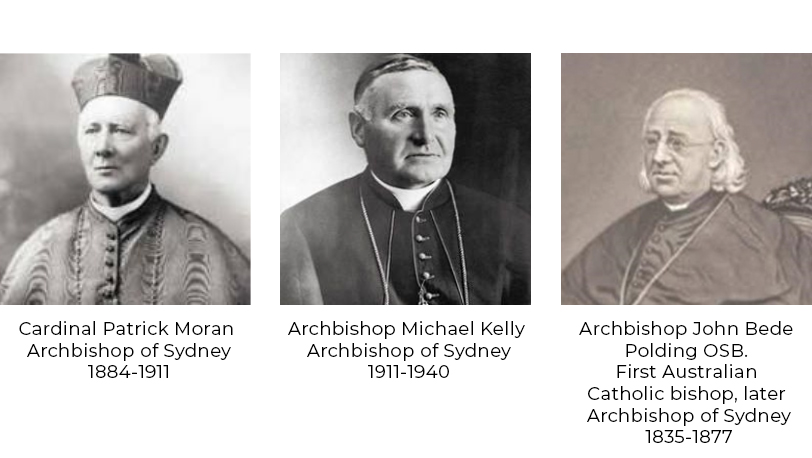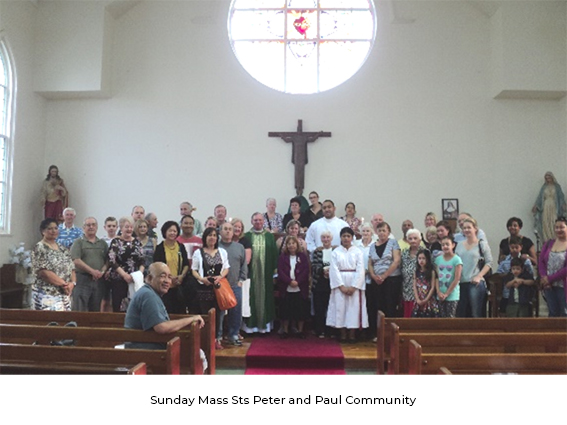Parish History
St Pius V Enmore (1906-present)
St Pius was established in 1906 as a school-church since St Joseph’s Newtown could not house the increasing numbers of new pupils. As part of the parish of Newtown its first parish priest was Dean Slattery. The Sisters of the Good Samaritan staffed the school (they already had charge of Newtown). The original church-school building is still extant. Formerly used as a parish hall it is now a preschool (not connected with the parish). Its foundation was blessed by Cardinal Patrick Moran.
In 1909 following Dean Slattery’s death St Pius V became an independent parish and Fr J Furlong the Parish Priest.
Around the same time, the Sisters of the Good Samaritan were no longer able to continue staffing the school therefore the Sisters of Mercy (Parramatta Congregation) took over and maintained a presence for well over seven decades. Initially they travelled from their convent at Kelvin Grove. In 1910 they bought Frankfort Park, opposite the church, from the Salvation Army. This became their convent and in due course they renovated the exterior of the front of the
building and added a chapel at the side.
This building has been through several uses since the departure of the Sisters but is now used as the parish house and contains the parish office. It was originally built by Albert M Smidmore whose father had bought extensive property in the area in the 1840s. The family had strong links with the early Catholic Church in Sydney, the foundation of Sts Peter and Paul at Cooks River and also St Joseph’s Newtown. For more details see https://marrickvilleheritage.org.au/2019/08/.
With Enmore’s expansion and an increasing population a new church was needed. In 1913 Archbishop Michael Kelly blessed the foundation stone. A presbytery was built next door (now converted to flats which are leased). The following year he blessed and opened the new (current church) and returned in 1915 to bless the foundation of the new school.
The primary school was expanded in 1923 and continues today – under lay leadership as it has for several decades. Enmore school had a strong tradition of musicianship – as did all the Parramatta Mercy schools – and this continued for many years. Like other parish schools, a girls’ high school was conducted on site (intermediate level) – closed in the mid 1960s. Today it is offers primary level education for both boys and girls (https://www.stpenmore.catholic.edu.au/).
Bishops
Fr James Carroll (1908-1995), a former parishioner and pupil of St Pius, was appointed PP at Enmore in 1944. He was made an auxiliary bishop to Cardinal Norman Gilroy (Archbishop of Sydney) in 1954 while still at Enmore. In 1965 he was made an archbishop. He played a prominent role in the development of Catholic education and was also influential within Labor Party circles (many prominent politicians were also Catholic). Both he and Gilroy helped to avert a split within the party such as took place in Victoria. Bishop Brian McGuckin (Toowoomba) is a former parishioner.

Sts Peter and Paul Cooks River Tempe (1858-2015)
The parish of Sts Peter and Paul* was amalgamated with Enmore after the primary school was amalgamated with St Pius V in 1990. The church was closed in 2015 as a regular Mass Centre.
1858 saw the establishment of the original church at Cooks River by Archbishop Polding in Unwin St (now Station St West Tempe). Local lay leaders, including Thomas Smidmore the son of a former convict and successful businessman and alderman, former convict Michael Gannon who donated land, and successful merchant Edward Campbell of Wanstead were among the local Catholics who requested a church. Its mission territory extended to the Hacking River and even to Botany. The primary school commenced at the same time. Originally the only church between St Benedict at Broadway and St Francis at Wollongong its development reflected the growth of the district from rural to suburban. The church celebrated its golden jubilee in 1908.
In 1912 Tempe became independent of Marrickville Parish, run by the Passionist Fathers. A new, bigger church was needed and it was established on what is now Princes Highway on land that had once been part of the Marionette Estate. The new church and presbytery were blessed and opened by Archbishop Kelly in 1913.
In the 1920s Tempe was responsible for the fledging parish of Earlwood. Fr J Smith PP procured the site for the church and school complex on Homer Street. At the end of the decade Earlwood became independent.
The Sisters of Mercy (Monte Sant’ Angelo congregation) took over the running of the school in
1903 from the lay headmistress (for most of its 45 years Sts Peter and Paul was conducted by
lay teachers except for a couple of years in the 1880s when two Good Sam Sisters taught at the school). Following the purchase of the old Way House in Hillcrest St from the Railway for use as a convent by the Sisters (they previously travelled from their convent at Erskineville) and the building of a new school next door, the pioneer church was closed and the site sold in 1916. The Sisters remained there till the early 1980s. For its remaining years it reverted to lay leadership
Ministries
The Sisters of the Good Samaritan bought Tempe House in 1885 and established a refuge and laundry caring for destitute women. They had a long association with the Tempe community. The laundry and other buildings have been replaced by high rise apartments; the area is now Wolli Creek. Tempe House and the Chapel remain. Built with convict labour by Alexander Sparke, a prosperous merchant, Tempe House served as a boarding school for girls run by Caroline Chisholm in the 1860s.
Also in 1885, a group of Carmelite nuns from France bought Thomas Holt’s castellated mansion at The Warren overlooking Cooks River nearby. After several years and financial difficulties they were evicted and founded a new convent at Dulwich Hill (now St Maroun’s School). The Warren was demolished after World War 1 – only two stone pillars remain in the park. (It has been featured in much of the hoardings round the new metro train line.) Ministry to patients at the Bayview Mental Asylum was a feature from the 1860s till its closure c 1939. Ikea and the old Penfold and DHA buildings currently occupy the site. Only the old fig tree is a reminder of the formal gardens that still existed in part till Ikea.

Community Heritage
It is largely due to the communities of religious women that once-grand houses in the district have survived so well. Tempe House (restored and occasionally opened), Way House (preserved but converted to several flats) and Frankfort House which, despite the 1920s façade, retains some original features of the Italianate home Smidmore built.
* A History Sts Peter and Paul Cooks River Tempe 1858-2008 was produced to commemorate 150 years (out of print).